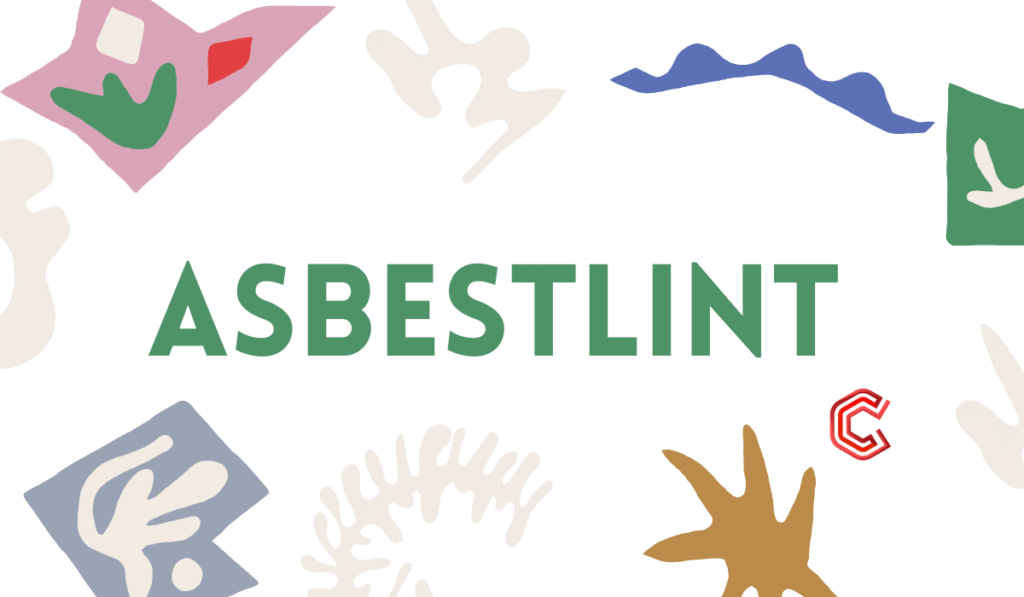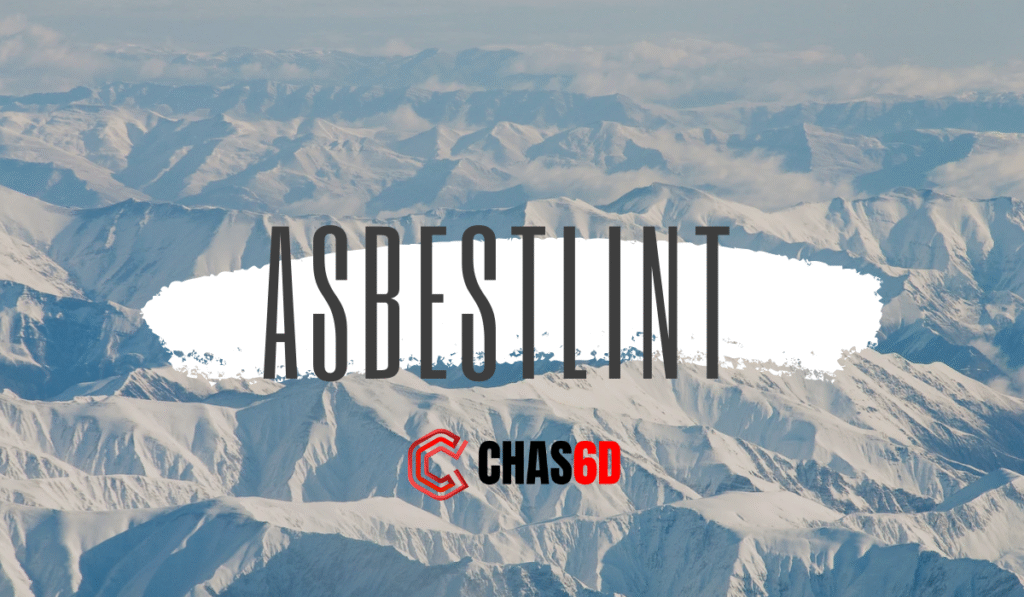Asbestlint is a term gaining attention across industrial safety, environmental health, and residential hazard discussions. Often overlooked, this fiber-like contaminant carries significant implications for human health and construction practices, especially in buildings dating back to the mid-20th century.
In this in-depth guide, we’ll uncover the unique nature of asbestlint, its sources, health implications, removal procedures, and long-term safety strategies. We’ll also explore how it differs from other forms of asbestos, emerging technologies for its detection, and international regulations shaping its control.
What Is Asbestlint?
At its core, asbestlint is a byproduct of deteriorating asbestos-containing materials (ACMs). Unlike solid asbestos fragments or panels, asbestlint refers specifically to the fibrous dust or lint-like particles that become airborne due to wear, friction, or degradation. The term combines “asbestos” and “lint,” highlighting both its composition and physical form.
While traditional asbestos exposure often involves large particles or composite panels, asbestlint poses an even more insidious threat: it is easily inhaled, invisible to the naked eye, and can persist in the air for extended periods.
The Origin and Spread of Asbestlint
The creation of asbestlint typically happens in environments where asbestos is either:
- Being disturbed by mechanical action (e.g., drilling, sanding, friction)
- Naturally breaking down due to age or environmental exposure
- Improperly stored or poorly encapsulated
Common locations where asbestlint might be found include:
- Older HVAC ducts lined with asbestos insulation
- Industrial machinery using asbestos brake pads or gaskets
- Flooring materials undergoing degradation
- Attics or crawl spaces with old insulation materials
Unlike larger asbestos pieces, asbestlint can be redistributed through ventilation systems, floor traffic, or cleaning tools like brooms or vacuums, making containment especially challenging.
Health Impacts of Asbestlint Exposure
Exposure to asbestlint carries the same—if not greater—risks as traditional asbestos due to its easily inhalable form. Once airborne, asbestlint particles can be deeply embedded in lung tissue, leading to conditions such as:
- Asbestosis – Chronic lung disease caused by scarring from inhaled asbestos fibers.
- Mesothelioma – A rare and aggressive cancer affecting the lining of the lungs or abdomen.
- Lung cancer – Increased risk due to long-term fiber inhalation.
- Pleural thickening – A condition that causes the pleura (lining of the lung) to harden and restrict breathing.
Microscopic Menace
What makes asbestlint particularly dangerous is its particle size. The fibers are often thinner than a human hair and can penetrate deeper into the lungs, avoiding the body’s natural defense mechanisms. Once embedded, they may lie dormant for decades before causing symptoms.
Asbestlint vs Traditional Asbestos
While often grouped under the same regulatory umbrella, asbestlint differs from general asbestos in several ways:
| Aspect | Traditional Asbestos | Asbestlint |
|---|---|---|
| Form | Sheets, tiles, insulation | Dust, fibers, lint |
| Visibility | Visible during installation or damage | Often invisible |
| Spread | Limited to impact zone | Easily airborne and widespread |
| Danger Level | High | Extremely high due to airborne nature |
In essence, asbestlint represents the most hazardous form of asbestos due to its microscopic, mobile nature.
Detection: How to Identify Asbestlint in Your Environment
Detecting asbestlint requires specialized equipment and expertise. Here’s how experts typically approach it:
- Air Sampling: HEPA-filtered pumps draw in air samples which are then analyzed under a polarized light microscope or electron microscope.
- Tape Lift Sampling: Adhesive slides are pressed against surfaces suspected of contamination and then examined in lab conditions.
- SEM Imaging (Scanning Electron Microscopy): Advanced imaging provides a high-resolution look at fiber size, shape, and distribution.
Red Flags for Homeowners
While laboratory testing is essential for confirmation, some warning signs may prompt immediate inspection:
- White or gray fibrous dust near insulation or ductwork
- Sudden respiratory issues in occupants without prior conditions
- Fine debris near aging tiles or wallboard
Professional Removal of Asbestlint
Given the danger of asbestlint, DIY removal is strongly discouraged. Instead, licensed asbestos abatement professionals follow strict protocols to contain and remove the material safely.

Key Steps in Professional Abatement:
- Site Isolation: Establishing negative air pressure zones and sealing the affected area.
- Protective Gear: Use of full-face respirators, disposable suits, and double-layered gloves.
- HEPA Filtration: Continuous air scrubbing to prevent fiber migration.
- Wet Methods: Keeping materials damp to minimize airborne particle release.
- Final Clearance Testing: Ensuring fiber counts fall below legal thresholds before reoccupying the area.
Cost Considerations
Removing asbestlint is often more expensive than removing solid ACMs due to its diffuseness. Costs may range from $2,500 to over $10,000, depending on the square footage, contamination level, and regulatory requirements.
Prevention and Long-Term Mitigation
Once asbestlint is discovered and removed, prevention becomes the next priority. Here’s how to protect your home or facility:
- Encapsulation: Sealing remaining ACMs with specialized coatings to prevent fiber release.
- HEPA Vacuum Systems: Regular cleaning using HEPA-filtered vacuums rather than standard ones, which can spread fibers.
- Air Quality Monitoring: Installing continuous particulate monitors to detect changes in indoor air fiber concentration.
- Renovation Control: Never drill, cut, or sand materials suspected of containing asbestos without professional testing.
Modern Technologies and Innovations in Asbestlint Control
Emerging technologies are transforming how we detect and manage asbestlint:
- Smart Air Sensors: IoT-connected sensors now offer real-time alerts when asbestos particles are detected in the air.
- AI Image Recognition: Machine learning systems trained on fiber patterns can detect asbestlint more accurately than manual methods.
- Nano-encapsulation Coatings: New chemical formulas penetrate micro-surfaces and permanently seal fibers in place, reducing airborne risk to nearly zero.
These advances provide hope for safer workplaces, schools, and homes without relying solely on reactive approaches.
Regulatory Standards Around Asbestlint
Most governments do not differentiate asbestlint specifically in their asbestos laws but regulate it under general asbestos dust guidelines.
United States (EPA & OSHA)
- PEL (Permissible Exposure Limit): 0.1 fibers per cubic centimeter of air (OSHA)
- AHERA: Requires inspections and management plans for schools
- NESHAP: Governs disposal and demolition of ACMs
European Union
- Directive 2009/148/EC: Covers worker protection, requiring asbestos inventories and exposure controls.
- ISO 22262-1: Standard for asbestos fiber counting and classification, including airborne particles like asbestlint.
Case Studies: Real-World Encounters With Asbestlint
Case 1: School Renovation in Ohio
A 2022 high school renovation in Ohio uncovered asbestlint behind ceiling panels. Air samples revealed fiber levels 3x the legal limit. The school district spent $1.4 million on cleanup and filtration upgrades. Students and staff were relocated for 6 months.
Case 2: Residential Discovery in Australia
A Melbourne homeowner reported persistent respiratory symptoms. Investigation found asbestlint generated by friction in the home’s 1960s-era air ducts. The remediation cost AU$18,000 and included full HVAC replacement.
The Future Outlook on Asbestlint
As global awareness of micro-particle pollution rises, asbestlint is likely to become a central focus of indoor air quality initiatives. Expect to see:
- More explicit legislation specifically naming asbestlint
- Insurance coverage shifts to include asbestlint-related damage
- Proactive monitoring in commercial and public buildings
- Training for HVAC professionals and janitorial staff on handling lint-based contaminants
Final Thoughts on Asbestlint
Though lesser-known than its solid counterpart, asbestlint may be the most dangerous form of asbestos exposure due to its mobility and invisibility. Proper detection, removal, and prevention are not optional—they are essential for long-term health and safety.
As we evolve our understanding of environmental toxins, asbestlint stands as a reminder that even microscopic materials can have massive impacts.
visit website for more: chas6d


